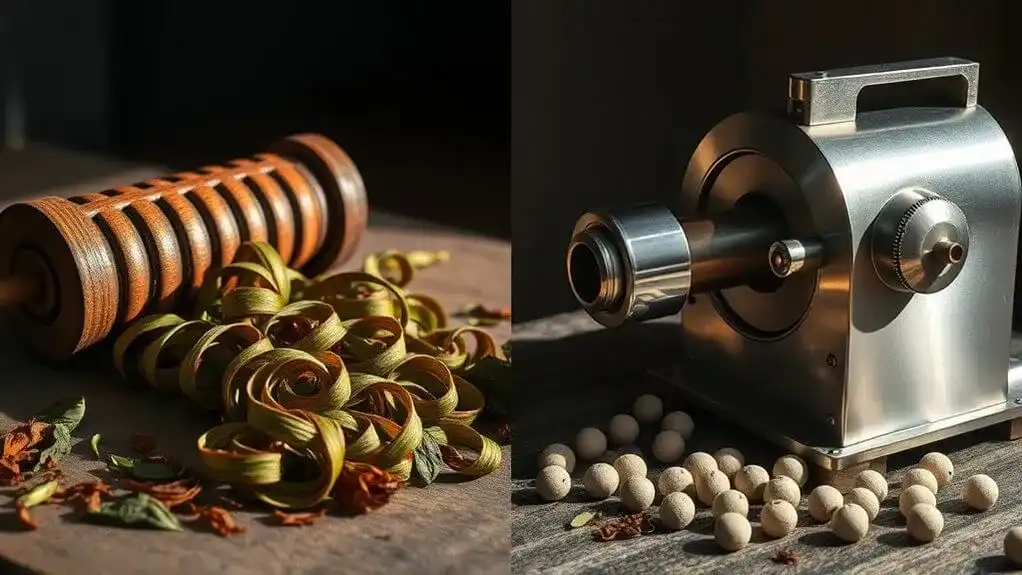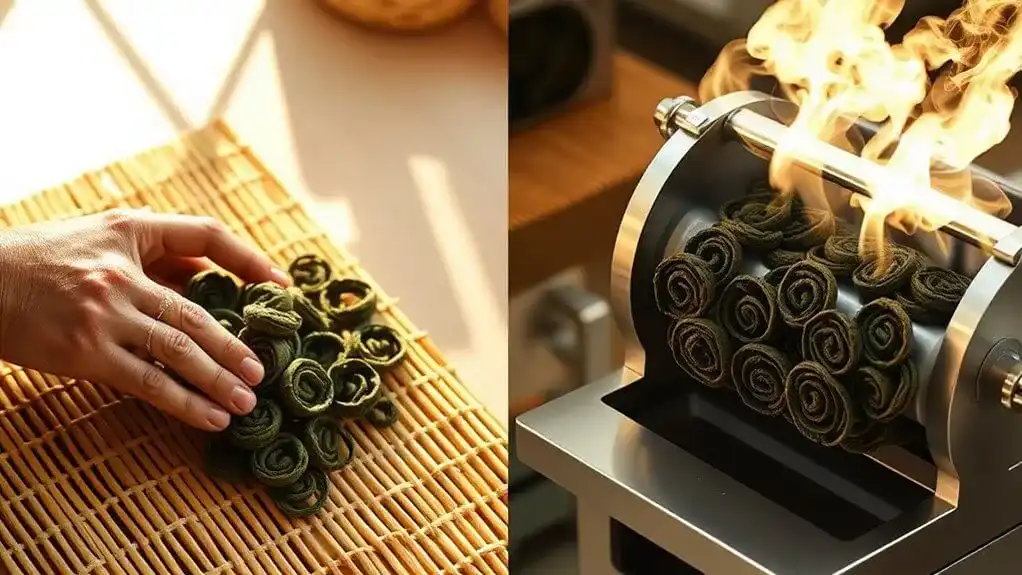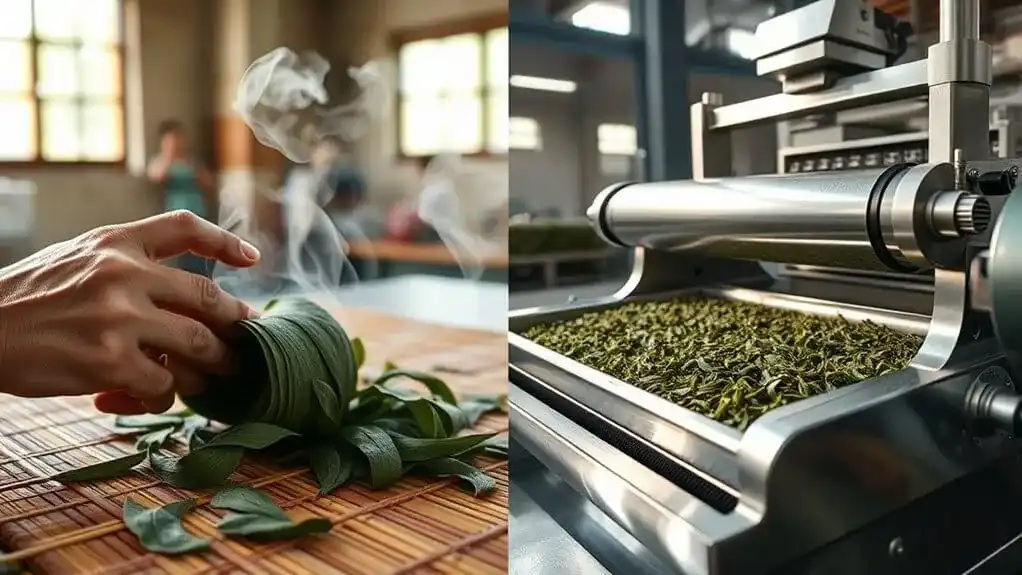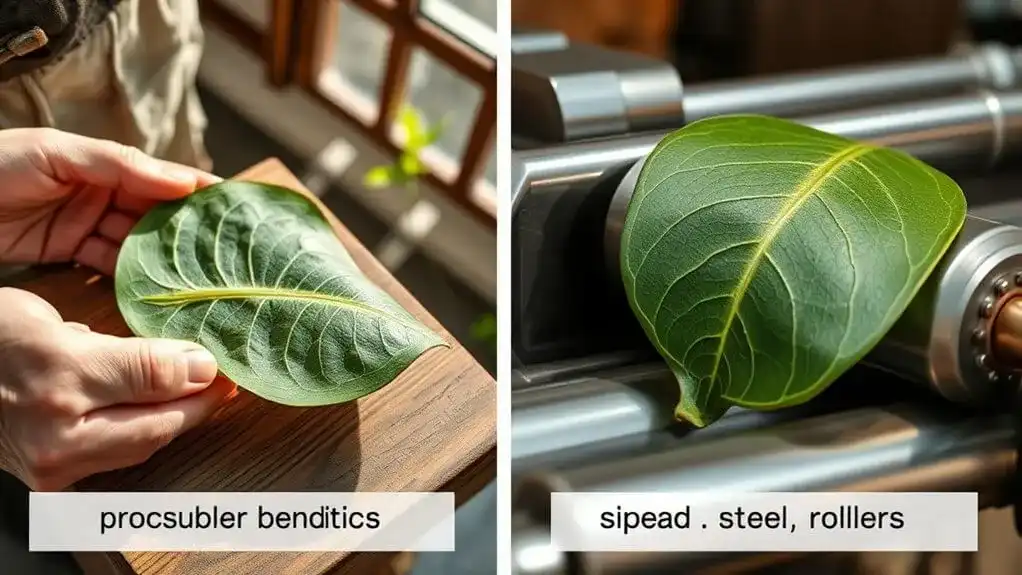Tea rolling transforms raw leaves into flavorful brews through cell wall breakdown and essential oil release. Traditional hand-rolling takes 6-7 hours for 300g of tea, creating delicate, nuanced flavors prized by connoisseurs. Modern mechanical methods boost efficiency while maintaining quality, processing larger quantities faster. The shape of rolled leaves directly affects brewing speed and taste complexity, with finer rolls producing quicker infusions. Tea's rich history of rolling techniques offers fascinating insights into this time-honored craft.
Key Points
- Traditional hand-rolling takes 6-7 hours per batch, creating delicate, nuanced flavors prized by connoisseurs over machine-processed alternatives.
- Modern mechanical rolling increases production efficiency while maintaining consistent quality, though potentially sacrificing some subtle flavor characteristics.
- Well-rolled tea leaves retain essential oils more effectively, producing richer and more complex taste profiles during brewing.
- Hand-rolling techniques allow for precise control over leaf shape, which directly influences brewing speed and flavor extraction.
- Different rolling methods create varied leaf shapes, affecting surface area exposure and ultimately determining tea's taste, aroma, and steeping characteristics.
The Art and Science Behind Tea Rolling

Craftsmanship meets chemistry in the intricate process of tea rolling. This vital step in tea production combines mechanical action with biochemical reactions to transform raw leaves into flavorful tea. Through precise flavor extraction techniques, tea rolling breaks down cell walls and releases essential oils that define a tea's character.
The process requires careful oxidation control, as exposure to air triggers chemical changes that develop unique taste profiles. For black teas, intense rolling accelerates oxidation, creating bold, robust flavors. In contrast, green teas undergo gentle rolling primarily for shaping, maintaining their delicate nature. Orthodox processing methods create diverse flavor profiles through traditional hand-rolling techniques. Modern mechanical rollers have revolutionized this traditional art, offering consistent results while preserving the fundamental principles of tea processing. The tender buds and leaves are considered most valuable for premium tea production. Oolong teas require multiple roll cycles to achieve their signature tight, compact shape. The interaction between physical manipulation and natural enzymatic reactions during rolling continues to shape the diverse world of tea production.
Understanding Traditional Rolling Techniques

While modern machines have streamlined tea production, traditional rolling techniques remain fundamental to creating exceptional teas. Hand rolling is an intricate leaf processing method that demands extensive skill and patience, typically requiring 6-7 hours to process just 300g of finished tea from 1.5kg of fresh leaves.
The process involves multiple precise steps, including blowing, rotation, massage-through, and twist-cutting techniques. A critical part of this process is the cloth sack packing step where leaves are carefully compressed. These movements carefully damage the leaf's cell walls to release essential oils and enzymes while maintaining the tea's artistic appearance. Each style of tea demands specific rolling approaches – oolong teas undergo multiple tight rolls in cloth sacks, while green teas receive gentler treatment to preserve leaf integrity. Black teas require vigorous rolling to initiate oxidation, and white teas typically skip the rolling process altogether unless crafted into pearl styles. Like writers who must maintain perfect conditions for optimal productivity, tea masters must work in climate-controlled environments to maintain optimal conditions for the tea leaves.
Modern Mechanization and Efficiency

As tea production has evolved over the decades, mechanical rolling equipment has revolutionized traditional processing methods, enabling tea manufacturers to boost output while maintaining quality standards. The mechanical systems provide consistent tea quality through precisely controlled rolling intensity. Modern mechanized rolling has dramatically improved efficiency by processing larger quantities of tea leaves in less time while ensuring consistent quality across batches. Black tea cultivation has particularly thrived in African nations like Kenya and Malawi.
The economic benefits are substantial, as these machines reduce labor costs while increasing productivity. They can operate continuously in various weather conditions, effectively doubling the output compared to manual methods. Today's rolling equipment often incorporates advanced features like sensors and data collection tools, allowing for precise control over the rolling process. While there are concerns about job displacement, many tea farms are addressing this through worker training programs that teach machine operation and maintenance skills.
How Leaf Shape Influences Taste and Aroma

The intricate shape of tea leaves plays a fundamental role in determining their taste and aromatic properties. When leaves are rolled, their cell walls break down, releasing essential oils that create distinct flavor profiles and aroma nuances. Well-rolled leaves retain these oils more effectively, resulting in richer, more complex tastes. The Wheel of Tea helps tasters identify and articulate the diverse flavor profiles created by different rolling methods. Jasmine Dragon Pearls represent one of the most skilled expressions of tea rolling craftsmanship, requiring expert tea masters to create their signature shape.
The level of rolling directly impacts how quickly tea infuses and its overall character. Finely rolled leaves brew faster due to increased surface area, while whole leaves offer a slower, more gradual release of flavors. Different shapes can evoke various taste experiences, from floral and fruity to earthy and spicy. The rolling method, whether mechanical or by hand, also influences the final outcome, with hand-rolled varieties often producing more delicate and nuanced flavors that tea connoisseurs particularly prize. In particular, the withering process first prepares the leaves by softening them to achieve the ideal pliability for rolling.
Cultural Significance and Regional Variations

Throughout history, tea rolling techniques have become deeply woven into the cultural fabric of societies along the Silk Roads, where distinct regional methods reflect centuries of tradition and craftsmanship. From China's diverse hand-rolling practices to Japan's meticulous sencha preparation, each region has developed its unique approach to tea processing, recognized as invaluable cultural heritage. These methods have been transmitted through traders, missionaries, and physicians, leading to fascinating regional adaptations. During the Tang period, tea shops flourished in Chang-an, establishing standardized processing methods that influenced tea production throughout Asia.
Tea rituals play a central role in community life, particularly in Eastern societies, where traditional techniques continue to influence modern practices. Notable examples include the hand-frying method for Longjing tea in China and the precise rolling techniques developed by Soen Nagatani in Japan. The introduction of mechanical rollers in the late 19th century marked a significant shift in production methods while preserving traditional quality standards. Today, these time-honored practices are being preserved through documentation and education, ensuring their survival for future generations. The process of hand-rolling requires six to seven hours to produce just 300 grams of finished tea, demonstrating the incredible dedication required for this traditional craft.
Conclusion
While modern machinery has streamlined tea production, it hasn't completely replicated the nuanced leaf shapes achieved through traditional hand-rolling methods. Some argue that mechanization produces consistent quality, but the subtle variations in hand-rolled leaves actually create more complex flavor profiles. The art of traditional rolling preserves cultural heritage while delivering unique taste experiences that machine processing can't fully match.

